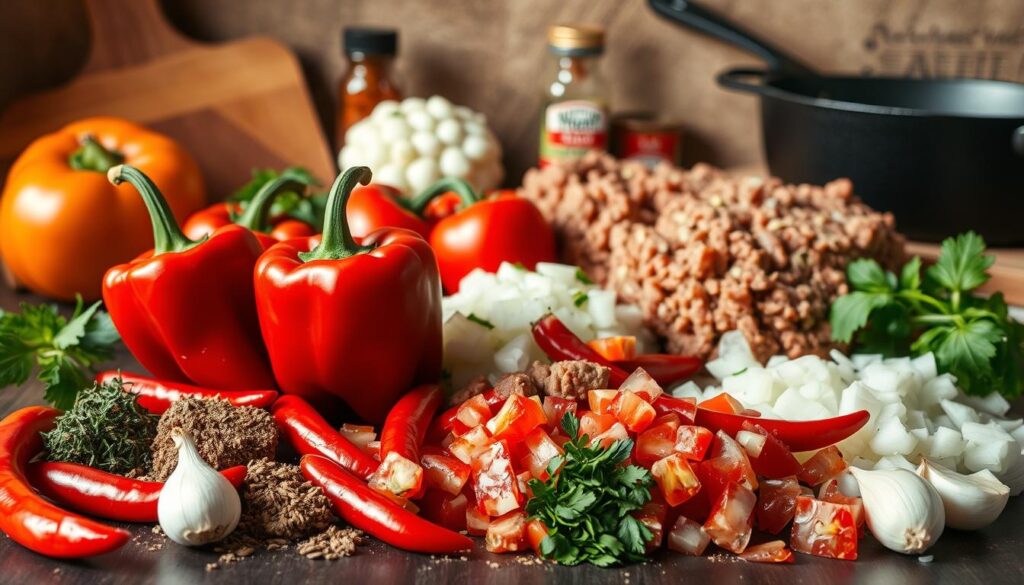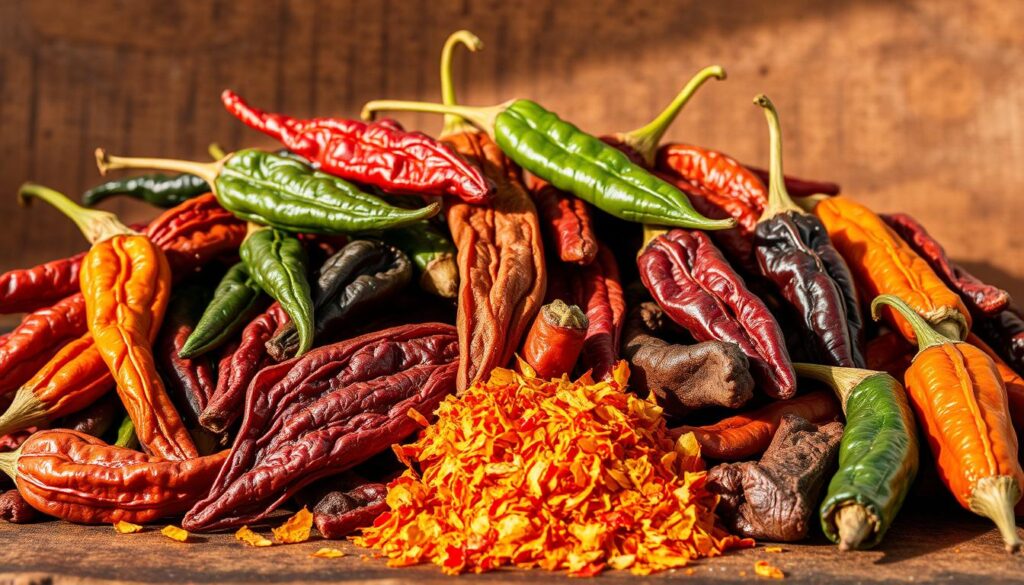There’s something special about a warm, hearty bowl of Chili con Carne that brings people together. For me, it’s more than just a meal—it’s a tradition that evokes memories of family gatherings and cozy nights by the fireplace. This iconic dish, with its rich flavors and robust texture, is a true celebration of culinary art.
Thank you for reading this post, don't forget to subscribe!At its core, Chili con Carne is a masterful blend of quality ingredients and time-honored techniques. The tender chunks of beef, the depth of slow-cooked flavors, and the subtle kick of spices all come together to create a dish that’s both comforting and sophisticated. Whether you’re a seasoned chef or a curious cook, this recipe promises to deliver an unforgettable experience.

Key Takeaways
- Chili con Carne is a classic Tex-Mex dish known for its rich, hearty flavor profile.
- Quality beef and a blend of spices are essential for an authentic taste.
- The slow-cooking process enhances the tenderness of the meat and depth of flavor.
- Customizable ingredients allow for personal touches to suit any palate.
- This recipe serves 4-5 people, making it perfect for family meals or gatherings.
Introduction to Chili con Carne
For me, Chili con Carne is more than just a meal—it’s a tradition that brings people together. This beloved Tex-Mex dish is a hearty blend of rich flavors and tender textures that has become a staple in my kitchen.
With its origins tracing back to the early 19th century in Texas, Chili con Carne has a deep history that reflects the cultural fusion of Mexican and American cuisines. The dish gained popularity during the Civil War period and became a sensation at the 1893 World’s Fair in Chicago.
| Aspect | Details |
|---|---|
| Prep Time | 15 minutes |
| Cook Time | Over 2 hours |
| Main Ingredients | Beef, chili peppers, tomatoes |
| Flavor Profile | Rich, hearty, slightly spicy |
The key to an authentic Chili con Carne lies in the quality of its ingredients and the slow-cooking process. This allows the flavors to meld together, creating a dish that’s both comforting and sophisticated. Whether you’re a seasoned chef or a curious cook, this recipe promises to deliver an unforgettable experience.
In the following sections, we’ll dive deeper into the ingredients, techniques, and cultural significance of this iconic dish, ensuring you have everything you need to create your own perfect batch of Chili con Carne.
The Rich History and Cultural Impact of Chili
Chili con carne holds a special place in the hearts of many, and its history is as rich as its flavor. Originating in the early 19th century in Texas, this dish has evolved from a simple cowboy stew to a beloved Tex-Mex classic.
Origins and Evolution of This Tex-Mex Classic
The story of chili con carne began with the Chili Queens of San Antonio, who started serving it in the 1860s. It gained national attention at the 1893 World’s Fair in Chicago, introducing chili to a broader audience. Over time, the recipe evolved, incorporating tomatoes and beans, though traditional Texas recipes still omit these.
Texas Traditions vs. Other Regional Favorites
While Texas proudly claims chili as its state dish since 1977, other regions have developed their own styles. Cincinnati, for example, serves chili over spaghetti with unique toppings, while Oklahoma includes beans, differing from the strict no-bean policy of Texas chili.
Chili’s cultural impact is undeniable. It became a staple during the Great Depression and even led to a congressional resolution in 1991, recognizing its significance. Today, it’s a comfort food enjoyed across the U.S., with variations that reflect local tastes and traditions.
For more on chili’s origins, visit this historical overview. If you’re looking to try a modern twist, consider crock pot recipes for a hearty meal.
Essential Ingredients for a Perfect Tex-Mex Chili
Creating an authentic Tex-Mex chili starts with selecting the right ingredients. Fresh produce and high-quality beef are the backbone of this dish, ensuring a robust and flavorful outcome.
Fresh Produce and High-Quality Beef
A good chili begins with fresh, aromatic ingredients. Chopped onions, bell peppers, and garlic form the foundation, adding natural sweetness and depth. For the beef, I recommend using premium cuts like chuck roast, which becomes tender and flavorful during the slow-cooking process.
The Role of Spices and Secret Additions
The magic happens with the spices. Chili powder, paprika, and a touch of cayenne pepper create a balanced, slightly spicy flavor profile. Don’t forget to measure precisely—use tablespoons and teaspoons to ensure each spice enhances the dish without overpowering it.
For that extra something, consider secret additions like a splash of beer or a sprinkle of cocoa powder. These subtle touches can elevate your chili from good to extraordinary.
| Ingredient | Quantity |
|---|---|
| Ground Beef | 2 lbs |
| Yellow Onion | 1 medium, chopped |
| Green Bell Pepper | 1 medium, chopped |
| Garlic | 4 cloves, minced |
| Chili Powder | 2 tablespoons |
For more inspiration, check out this Mexican chicken marinade for a flavorful twist on your next meal.

Mastering Techniques: Searing, Stewing, and Flavor Building
When it comes to crafting a memorable Chili con Carne, technique plays a pivotal role. The way you handle the ingredients and manage the cooking process can elevate your dish from ordinary to extraordinary.
Searing the Beef for Optimal Browning
Searing the beef is the first step in building a robust flavor profile. Using high heat ensures a nice crust forms on the meat, which is essential for that deep, savory taste. I always make sure to pat the beef dry before searing to get the best results.
Slow Cooking Methods to Enhance Texture
After searing, the beef needs time to become tender. Slow cooking in a heavy pot breaks down the connective tissues, turning them into gelatin for a melt-in-your-mouth texture. This process requires patience, but the end result is well worth the wait.
| Technique | Description |
|---|---|
| Searing | High heat to achieve optimal browning and flavor. |
| Slow Cooking | Breaking down connective tissue for tender meat. |
| Maillard Reaction | Chemical reaction enhancing flavor complexity. |
Balancing high heat for flavor and moisture retention is crucial. By mastering these techniques, you’ll create a dish that’s both flavorful and tender, ensuring every bite is a delight.
My Step-by-Step Chili con carne Recipe
Let’s dive into my personal, time-tested recipe for this beloved dish. I’ll guide you through every step, from prepping the ingredients to the final simmer, ensuring you end up with a flavorful, hearty meal.
Preparation and Ingredient Assembly
Start by gathering all your ingredients in one place. This makes the cooking process smooth and enjoyable. Chop the onion and bell pepper finely, and mince the garlic. Brown the beef in a hot pot, breaking it into small pieces as it cooks. Once the beef is browned, add the chopped onion, bell pepper, and garlic, stirring well to combine.
Next, stir in the chili powder, paprika, and cayenne pepper. Let these spices cook for about a minute to release their flavors. This step is crucial for building the dish’s foundation.
Cooking Process and Timing Adjustments
Add the diced tomatoes, tomato paste, and beef broth to the pot. Stir everything together, then bring the mixture to a boil. Reduce the heat to low and let it simmer for about an hour, stirring occasionally, until the flavors have melded together and the beef is tender.
After 30 minutes of simmering, add the beans and any additional spices to taste. Continue cooking for another 20-30 minutes, allowing the flavors to blend. If the chili becomes too thick, add a little water. If it’s too thin, let it cook uncovered for a few minutes to thicken.
For more tips on achieving the perfect consistency, visit this detailed guide.
The Role of Dried Chiles in Authentic Texas Chili
Dried chiles are the heart and soul of a true Texas chili. They bring depth, complexity, and a richness that you just can’t replicate with chili powder. I’ve learned from experts at Serious Eats that using whole dried chiles instead of pre-ground powders makes all the difference.
Selecting the Perfect Dried Chiles
Choosing the right chiles is like picking the best ingredients for any recipe. Ancho chiles offer a sweet, slightly smoky flavor, while guajillo chiles add a bright, tangy note. For a spicy kick, a few chiles de arbol can elevate the heat. Each type brings its own unique character to the pot.
- Ancho chiles: Sweet and smoky
- Guajillo chiles: Bright and tangy
- Chiles de arbol: Hot and intense
Rehydrating and Blending Chiles
To get the most out of your chiles, start by toasting them lightly in a pan. Then, soak them in boiling water for about 30 minutes until soft. Blend them with some of the soaking water to create a smooth, vibrant sauce. This step is crucial for a deep, authentic flavor.

By focusing on quality dried chiles and avoiding generic powders, you’ll craft a chili that’s rich, balanced, and full of authentic Texas flavor. It’s all about layering those natural flavors to create something extraordinary.
Creative Chili Twists and Customizations
Chili is more than just a dish—it’s a canvas waiting for your personal touch. Whether you’re a traditionalist or an adventurous cook, there are countless ways to make this beloved recipe truly yours. Let’s explore some creative twists that can elevate your chili game.
Adding Unique Ingredients for a Personal Touch
One of the easiest ways to customize your chili is by experimenting with ingredients. Beans are a classic addition, offering both texture and protein. Try mixing in black beans, pinto beans, or even baked beans for a sweeter twist. Corn is another great addition, adding a burst of freshness and crunch to each bite.
For those who like a little heat, adding extra spice can make all the difference. A pinch of cayenne pepper or an extra sprinkle of chili powder can elevate the flavor profile. Don’t forget to explore other ingredients like diced tomatoes or a splash of beer to deepen the flavor.
Modern Toppings to Elevate Your Bowl
Toppings can transform a good chili into a great one. Grated cheese like cheddar or Monterey Jack adds a creamy, tangy touch. Fresh herbs such as cilantro or scallions bring a bright, fresh flavor. For a luxurious finish, try a drizzle of spiced sour cream or a sprinkle of crushed tortilla chips for added crunch.
Remember, the beauty of chili lies in its versatility. Whether you’re adding beans, corn, or a variety of cheeses, each choice reflects your personal style. Don’t be afraid to mix and match—after all, the best chili is the one that tells your story. So go ahead, get creative, and make every bowl a delicious reflection of you!
Serving Suggestions and Perfect Pairings
Now that your chili is ready, it’s time to think about how to serve it. This is where you can get really creative and make every bowl unique!
Cornbread, Tortillas, and Complementary Sides
A warm slice of cornbread or some crusty tortillas are classic pairings that complement the hearty flavors of your dish. For a more filling meal, consider adding sides like coleslaw or a fresh green salad to balance the richness.
Here are some popular serving suggestions to enhance your meal:
- Cornbread muffins for a sweet contrast
- Warm flour or corn tortillas for scooping
- Coleslaw for a refreshing crunch
- Baked potatoes topped with cheese and onions
| Side Dish | Description |
|---|---|
| Cornbread | Perfect for scooping up every bite |
| Tortillas | Warm and ideal for wrapping |
| Coleslaw | Adds a cool, crunchy contrast |
Timing is everything. Make sure all elements are ready when you serve. A pinch of salt, some diced onion, and a dollop of sour cream can elevate the presentation. Don’t forget a sprinkle of fresh cilantro for that extra pop of color and freshness!
Conclusion
As we conclude this journey through the world of Chili con Carne, it’s clear why this dish holds such a special place in culinary history. From the careful selection of ingredients to the precise techniques that bring it all together, every step is a testament to tradition and innovation.
The heart of this recipe lies in its simplicity and depth. Quality beef, a medley of peppers, and the slow-cooking process each play a vital role. Whether you’re adding beans, experimenting with spices, or keeping it true to Texas roots, the flexibility of this dish is part of its charm.
When it’s time to serve, don’t be shy with the toppings. A sprinkle of cheese, a dollop of sour cream, or a handful of fresh cilantro can elevate each bowl. Pair it with cornbread or a crisp salad for a meal that’s both hearty and balanced.
Remember, the best part of this recipe is its ability to evolve. Take the foundation and make it your own, whether that means adding a splash of beer or a pinch of cinnamon. The beauty of Chili con Carne is that it’s never just one thing—it’s a canvas waiting for your personal touch.
So, the next time you simmer a pot, let the flavors meld overnight. Trust me, it will be even better the next day. And when you take that first bite, remember the generations of cooks who’ve perfected this dish before you. Then, make it your own and pass it on.
FAQ
What type of beef is best for chili con carne?
Ground beef is the most common choice, but you can also use diced beef for a heartier texture. Opt for 80/20 ground beef for the right balance of flavor and fat.
Can I make chili con carne without beans?
Absolutely! Traditional Texas-style chili often skips beans, focusing on the rich flavors of the meat and spices. You can always add beans later if you prefer a vegetarian version.
How do I adjust the heat level in my chili?
The heat level depends on the type and amount of peppers or chili powder you use. Start with a small amount and taste as you go, adding more heat to your liking.
What’s the best way to cook chili con carne?
Browning the beef and sautéing the onions and garlic first builds a solid flavor foundation. Then, simmering the mixture low and slow enhances the texture and depth of the dish.
Can I make chili con carne in under an hour?
While slow cooking is ideal, you can make a quicker version by using higher heat and shorter simmering times. However, the flavor will be best if you give it at least 1-2 hours.
How should I store leftover chili?
Let it cool completely, then refrigerate or freeze it in an airtight container. It will keep for up to 3 days in the fridge and 3 months in the freezer.
What are some good toppings for chili con carne?
Popular toppings include shredded cheese, sour cream, diced onions, and fresh cilantro. You can also add a sprinkle of corn or a side of tortillas for extra flavor.
Is chili con carne healthy?
Yes! It’s packed with protein from the beef, fiber from the beans and vegetables, and antioxidants from the spices. Just keep an eye on the fat content if you’re watching your diet.
Can I make chili con carne in a slow cooker?
Absolutely! Brown the beef and cook the vegetables in a skillet first, then transfer everything to the slow cooker and let it simmer on low for 6-8 hours for tender, flavorful results.
What spices are essential for authentic chili con carne?
Chili powder, ground cumin, garlic powder, and paprika are must-haves. For extra depth, add a pinch of cayenne pepper or dried oregano.
There are no reviews yet. Be the first one to write one.

